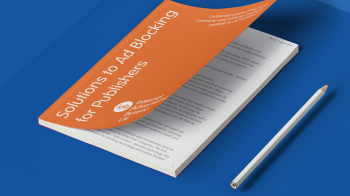Defending against ad fraud: what publishers need to do
John Murphy
John Murphy, VP, Marketplace Quality at OpenX argues that publishers cannot afford to sit idly on the sidelines waiting for other parties to clean up ad fraud.
Digital advertising fraud – set to cost the industry over $16 billion this year – has long been viewed as a buy-side problem. After all, advertisers are the ones spending money on ads seen by bots or never seen at all. But the truth is all players in the industry feel the impact of ad fraud, and publishers cannot afford to sit idly on the sidelines waiting for other parties to clean up the mess. Premium publishers are particularly at risk for fraudulent practices. Fraud is known to artificially inflate the volume of digital inventory available and lead to poor advertising performance, reducing CPMs and jeopardising publishers’ relationships with advertisers. It also reduces ad quality, which negatively impacts the user experience – a top concern for publishers.
So what types of fraud specifically impact premium publishers, and what measures can they take to protect themselves?
There are three emerging types of advertising fraud premium publishers should have top of mind. The first is domain spoofing or impression laundering, which is seeing a resurgence due to the increased use of server-to-server connections that limit data integrity by preventing exchanges that validate the domain at the time of request. Domain spoofing was widely used by the Methbot operation to target over 6,000 premium domains. A second type of ad fraud is unauthorised resale, where third party networks engage in arbitrage to repackage and resell inventory from premium publishers without their consent. Finally, ad unit misrepresentation, which usually occurs when display inventory is resold by a third party as pre-roll video inventory, to take advantage of the higher CPMs to be gained from video.
The way these types of ad fraud harm publishers is by exaggerating inventory availability, and by delivering poor performing traffic, hence reducing demand for genuine premium inventory. This leads to lower CPMs for publishers. Direct relationships with demand side platforms (DSPs) or buyers are also being affected. Buyers may wrongly blame genuine publishers for poor performance and may demand additional verification for subsequent programmatic buys, which can be costly for the publisher. And of course, the user experience. By serving poor quality ads, or by delivering ads that are slow to load, heavy on data, and too small to view properly, user experience can be easily diminished.
To significantly reduce the threat of ad fraud, publishers need to take proactive measures to protect themselves and, in the process, have a hand in cleaning up the industry of bad actors.
Run buying tests against inventory
Publishers can get a better of understanding of how their inventory is being presented to – and seen by – the demand side by setting up programmatic buying tests against their own domains. The Guardian set up buying tests last year when it discovered that – in some cases – it was only receiving 30% of ad spend.
As part of these tests publishers should look for sizes or ad formats they know are limited or unavailable, and should make use of third-party verification for non-human traffic, invalid traffic, and domain verification.
Select monetisation partners carefully
Publishers should only work with monetisation partners that place quality and fraud prevention as a high priority. They should use industry rankings such as Pixalate’s Global Seller Trust Index when choosing monetisation partners – only working with technology providers found towards the top of the index.
Before beginning a relationship with a technology company to sell their inventory, publishers should complete a thorough review of the quality protections a potential partner has to offer. Ask if the partner prohibits resale of ad impressions by DSPs, whether they employ post-impression validation to detect domain spoofing, and if networks are required to prove they are authorised to sell premium inventory on the publisher’s behalf. Not all partners provide the same level of quality protection.
Publishers may also want to ask about the availability of even more sophisticated tools, like an ad quality scanner, to protect against malicious, or just generally bad, ads. Preserving the user experience means being able to detect ads that could slow down or disrupt the page before they occur.
And, ensuring high quality doesn’t stop with partner selection. Publishers must work actively with their partners to identify instances of fraud and misrepresentation, and should insist on full disclosure of all responsible parties. When instances of fraud are discovered publishers must alert all partners that may be impacted and take the necessary legal action.
Support wider industry efforts
The digital advertising industry is making strides in enhancing quality and preventing fraud. This includes the development of technical standards such as TAG-ID, TAG Payment ID, and Open RTB 3.0, as well as programmes such as the IABs Ads.Txt initiative, TAG Anti-Fraud Certification and TAG Inventory Quality Guidelines. But these initiatives can only work with the support and participation of the entire industry, including publishers who can use their voice to educate others.
Work directly with advertisers
The complexity of the digital advertising ecosystem allows fraudulent practices to thrive, so by creating more direct relationships with advertisers publishers can reduce their risk. They should talk to advertisers and use known instances of fraud to support the case for direct relationships formed through private marketplaces and programmatic guaranteed.
It’s clear that fraud impacts the sell side as much as the buy side, so it’s time for publishers to empower themselves with proper strategies to protect their business. By choosing to work with partners that prioritise quality and fraud prevention they are taking the first steps to fight ad fraud and create a cleaner industry. With the right partners onboard, they’ll be able to continue their crime-fighting mission, take action against misrepresentation, test their own inventory, support industry initiatives, and form close relationships with advertisers to crack down on fraud.
Related content
Ad Blocking: Consumer Notice Guide for Publishers
Learn moreSolutions to Ad Blocking for Publishers
Learn moreNew ad metrics for publishers on Google
Learn moreFive rules to ensure the quality of your digital advertising
Learn more
Fast forward to 2030 with Futurescape
An in-depth exploration of the attitudes, innovations and media shifts that will shape the years ahead and redefine how we advertise by the turn of the decade



